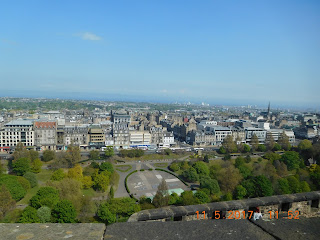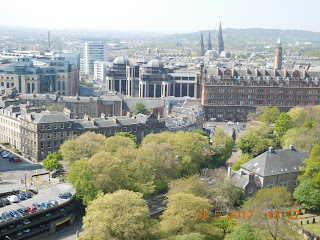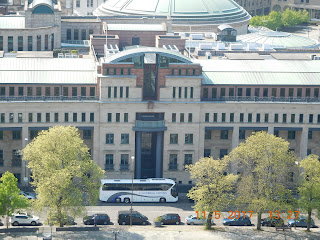11th May 2017 (Thursday)
Fourth Day. Trip to Edinburgh! I really love green rolling hills, historic buildings, glamorous city centers and medieval castles, so Edinburgh was always on my list of places to visit...
In the morning we caught a bus headed to Edinburgh... While taking a bus is slower than the train it's significantly cheaper and can take as little as 1hour and 15 minutes to arrive in Edinburgh... We purchased a return ticket (less than 12€). De driving distance between Glasgow and Edinburgh is only 75 km (46 miles) so you could leave and go back on the same day
In the morning we caught a bus headed to Edinburgh... While taking a bus is slower than the train it's significantly cheaper and can take as little as 1hour and 15 minutes to arrive in Edinburgh... We purchased a return ticket (less than 12€). De driving distance between Glasgow and Edinburgh is only 75 km (46 miles) so you could leave and go back on the same day
The Glasgow Royal Concert Hall
Buchanan bus station is the main bus terminus in Glasgow. It's the biggest bus station in Scotland with around 1,700 bus journeys departing from there every day and over 40,000 passengers using these journeys on a daily basis
Waiting for our bus...
We took the The Citylink Glasgow - Edinburgh
Scottish Citylink is a long distance express coach operator in Scotland and Ireland (where it operates as Irish Citylink) and England (where it operates as Stansted Citylink). The company was formed as a subsidiary of Scottish Transport Group in March 1985. Since September 2005 it has been operated as a 65/35 joint venture between ComfortDelGro and Stagecoach
Already inside
Here we see John Lewis/Buchanan Galleries car park directly opposite the station
More pics during the bus journey. The megabus from Glasgow to Edinburgh takes an average of 1 hour and 20
minutes, up to a maximum of 2 hours. There are 75 coaches running on
this route every day, which makes this one of the most well-served
routes on the megabus network
Travelling along Edinburgh Road in the east end of Glasgow. This is looking over the Greenfield area, towards Cathkin Braes in the distance
Also Edinburgh Road, passing through the Carntyne area. These are suburban streets in the east end of Glasgow
Again, Edinburgh Road travelling out of Glasgow. This is Barlanark-Greyfriars Church in the Barlanark area to the east of Glasgow
Bus is on the Newbridge Roundabout on outskirts (west) of Edinburgh
Pentland Jaguar car dealership, Glasgow Road, Edinburgh
Edinburgh! Church of St John the Evangelist
The church with Scottish flag... A Scottish Episcopal church in the centre of Edinburgh. It is sited at the west end of Princes Street at its junction with Lothian Road, and is protected as a category A listed building
The bus arrives in the centre of Scotland’s capital
The street where the bus stopped: Princes Street
Princes Street is one of the major thoroughfares in central Edinburgh and the main shopping street in the capital. It is the southernmost street of Edinburgh's New Town, stretching around 1 mile (1.6km) from Lothian Road in the west, to Leith Street in the east
The street is mostly closed to private cars, with public transport given priority. The street has virtually no buildings on the south side, allowing panoramic views of the Old Town, Edinburgh Castle, and the valley between
Only the east end of the street is open to all traffic.
The bulk of the street is limited to trams, buses and taxis
Frederick Street
The historical building behind me is The Scottish National Gallery, the national art gallery of Scotland, located on The Mound in central Edinburgh
The Scottish National Gallery is a neoclassical building designed by William Henry Playfair, and first opened to the public in 1859. The gallery houses the Scottish national collection of fine art, including Scottish and international art from the beginning of the Renaissance up to the start of the 20th century
In the center of the city is the large hill that Edinburgh Castle sits on
The Mound
The Mound is an artificial hill which connects Edinburgh's New and Old Towns. It was formed by dumping around 1,501,000 cartloads of earth excavated from the foundations of the New Town into Nor Loch which was drained in 1765 and forms today's Princes Street Gardens. The construction of the Earthen Mound, as it was originally called, was begun in 1781 and it was extended over the years until by 1830 it was macadamised and landscaped so that it appeared more or less complete. When the Edinburgh and Glasgow Railway was extended to Waverley station in 1846, tunnels were driven under The Mound to allow access to the west.
Today The Mound is a busy, if fairly steep, thoroughfare taking traffic to and from Princes Street and the Royal Mile in the Old Town. The lower end, or 'Foot' of the Mound is a few metres walk from the Princes Street tram stop. Due to its raised elevation, the Mound commands expansive views over Princes Street and the New Town of Edinburgh and towards Calton Hill
The historic Ramsay Garden area. Quiet and superb surroundings
Ramsay Garden is a block of sixteen private apartment buildings in the Castlehill area of Edinburgh, in the heart of Edinburgh's Old Town... They stand out for their red ashlar and white harled exteriors, and for their prominent position, most visible from Princes Street
Spectacular views
More cottages, housing, apartments... in Ramsay Garden, near the Castle. Blue doors, red stairs,etc. The development features traditional domestic Scottish architecture with a profusion of balconies, towers, and castle-like elements--beautiful and fanciful, and bright red trim
Tartan Weaving Mill and Experience sign, 555 Castlehill
The Scotch Whisky Experience 354 Castlehill
Upper Bow and Santa Columba's Church
Edinburgh has a special charm that comes from the old and historic buildings throughout the city...The view up or down... everything is worth a moment of pause
Best Gift Shop on the Royal Mile
Traditional Scottish souvenirs...
Edinburgh Castle is a must see when visiting the city. It’s hard to miss, as it sits above everything else in city center... It's a historic fortress which dominates the skyline of the city from its position on the Castle Rock 😍 The castle is Scotland's most-visited paid tourist attraction. It's expensive, but it's well worth paying that price...
Welcome to Edinburgh Castle!
Edinburgh Castle stands at the head of the Old Town. It's built on a volcanic rock
The Gatehouse
The castle's position on the volacnic rock offered protection from all sides with steep rocky faces all round and the Nor' Loch to the North. The Gatehouse, which faced the sloping town (the Royal Mile) was the most vunerable point to attack
However, The Gatehouse, an impressive main entrance into the castle was built, not so much as an additional defence but rather for aesthetic reasons. It replaced a simple functional gate which was built in the late 17th century. Flanking the main arched entrance stand bronze statues of two of Scotland hero freedom fighters, William Wallace and Robert the Bruce, added in 1929
Royal coat of arms of Scotland on the gatehouse of Edinburgh Castle
Portcullis Gift Shop
A Union Jack flying
The castle is a great place to look out over the entire city
Dog Cemetery
Off the main path at Edinburgh Castle, a small garden space holds a soldiers’ dog cemetery dating back to 1840. The site of the cemetery may have once been a tower, but it now acts as the final resting place for honored canine companions of the regimental officers. Visitors cannot enter the cemetery, but it can be viewed from above
The small garden below has been used since Queen Victoria's Reign (1837-1901) as a burial place for regimental mascots and officers dogs... Located within the castle walls near Mill’s Mount, from where the One O’Clock Gun is fired, the pleasant little cemetery serves as final resting place of regimental mascots and officer’s pet dogs
Amazing views of the surrounding city
Roser and I with beautiful views behind us
St. Margaret's Chapel
St Margaret’s Chapel is the oldest building within the Castle walls and was built on the highest point of the Castle Rock in the 12th Century
Queuing up to get in
The small irregular stone building has some similarity to earlier Scottish and Irish Celtic chapels. The rectangular structure with an internal width of 3 metres (10 ft) has an entrance door at one side near the back of the nave which is 4.87 m (16 ft) long, then a typically Romanesque round chancel arch 1.52 m (5 feet) wide with chevron mouldings decorating the arch above columns on each side leads into an apsed sanctuary 3 m long, with the apse having a radius of 1.52 m. The north wall has been renewed, and the three surviving outer walls are 61 cm (2 ft) thick, as is the chancel wall
St Columba
St Margaret of Scotland
David's Tower
The Honours: The Scottish Crown Jewels
The Honours of Scotland, also known as the Scottish Regalia and the Scottish Crown Jewels, dating from the fifteenth and sixteenth centuries, are the oldest surviving set of crown jewels in the British Isles. They were used for the coronation of Scottish monarchs from 1543 (Mary I) until 1651 (Charles II). Since then, they have been used to represent Royal Assent to legislation in both the Estates of Parliament and the Scottish Parliament, and they have also been used at state occasions including the first visit to Scotland as sovereign by King George IV in 1822 and the first such visit by Queen Elizabeth II in 1953
Kings of Scotland display
The Seat of Kings
Robert The Bruce Crowned With a Circlet of Gold 1306
Symbols of Ceremony
The Royal House of Stewart - The early kings and their consorts
Founding a Dinasty
Papal presentations
Relinquishing the Crown. The abdication of Mary, Queen of Scots, has been illustrated many times. This painting, by Gavin Hamilton (1773), is a rather melodramatic image of the imprisoned Queen giving up her Crown
The Coronation of Charles II at Scone
The Honours in Danger
The Honours Saved From Cromwell. Tableau at Edinburgh Castle
Rediscovering the Honours in 1818. Tableau at Edinburgh Castle
Sword of State of Scotland
The Sword of State of Scotland was also a papal gift; Pope Julius II presented it to James IV in 1507 (see Blessed sword and hat). The etched blade, measuring 4.5 feet in length, includes figures of Saint Peter and Saint Paul, as well as the etched name of Julius II. The silver gilt handle bears figures of oak leaves and acorns. The sword, an example of Italian craftsmanship, was damaged in 1652 whilst being hidden from Cromwell's troops, as it had to be broken in half to be properly concealed while it was being taken to safety. It is accompanied by a wooden scabbard which is covered with velvet and silver and hung from a woven silk and thread of gold belt
Additions to the Honours
Charles II
Queen Mary's Bedchamber
Mary Queen of Scots
The Royal Apartments
Rooms in Royal Palace
The Scottish National War Memorial
The Scottish National War Memorial occupies a converted barrack block on the north side of Crown Square. It stands on the site of the medieval St. Mary's Church which was rebuilt in 1366, and was converted into an armoury in 1540. It was demolished in 1755, and the masonry reused to build a new North Barrack Block on the site
The Prisons of War exhibition and vaults
This prison recreation offers a glimpse of life for the prisoners of many nationalities who languished here. They came from as far apart as France, America, Spain, the Netherlands, Ireland, Italy, Denmark and Poland. Among them was five-year-old drummer boy captured at the Battle of Trafalgar in 1805
Prisons of war
Independence
Jacobites
Private Robert Ewing (26th Cameronian Regiment). Charge: Drunk on guard. Sentence: 2 months hard labour and 2 months solitary confinement. Date: July, 1844. Photo taken at Military Prison
Robert Ewing (age 24), from Bonhill in Dunbartonshire, had been in the army 4 years when he was caught drunk on guard whilst stationed here in Edinburgh Castle. It was a serious offence.
You see him serving the first part of this sentence-hard labour. This was usually shot drill, but other punishments were issued. Here Private Ewing is seen separating the strands of old tarred rope, or oakum, fore re-use. Other punishments included stone breaking or yard cleaning.
During the remainder of this 21 years of army service, Private Ewing served in the East Indies, China and Bermuda earned good conduct pay and badges
The Royal Scots Dragoon Guards (Carabiniers and Greys), a cavalry regiment of the British Army, and the senior Scottish regiment. The regiment, through the Royal Scots Greys, is the oldest surviving Cavalry Regiment of the Line in the British Army. The regiment is currently based at Leuchars Station, as part of the Scottish 51st Infantry Brigade
This Museum was opened by Her Majesty The Queen Colonel-in-Chief.
The Royal Scots Dragoon Guards on 6th July 2006
Welcome to the Regimental Museum of the Royal Scots Dragoon Guards
Regimental Deployments
Amazing views
Memorial to the glorious memory of those officers non comissioned officers and men of the royal scots greys who fell in the Great War (1914-1918). This club was founded in 1922
Regimental deployments from 1902
National service and modern times. Time of change: mechanisation and amalgamation
Statue in front of the Royal Scots Dragoon Guards museum in Edinburgh Castle
National War Museum
This museum contains a wealth of absorbing material that ranges from letters home from foreign campaigns to Highland broadswords and chemical warfare suits.
The Scottish National War Museum is housed in a former storehouse for ordnance. It was built in the 1700s and later used as a military hospital.
The museum opened in 1933 and is now run by the National Museums Scotland.
The large and fascinating collection includes many artefacts used by the Scottish forces over the centuries, plus paintings including Robert Gibb’s famous “Thin Red Line”, and a research library
Equestrian statue of Field Marshal Earl Haig, National War Museum in Hospital Square
Stunning panoramic views
Talking telescope
National War Museum - The story of Scotland at war
25-pounder field gun
The Ordnance QF 25-pounder, or more simply 25-pounder or 25-pdr, was the major British field gun and howitzer during the Second World War, possessing a 3.45-inch (87.6 mm) calibre. It was introduced into service just before the war started, combining high-angle and direct-fire, relatively high rates of fire, and a reasonably lethal shell in a highly mobile piece. It remained the British Army's primary artillery field piece well into the 1960s, with smaller numbers serving in training units until the 1980s. Many Commonwealth of Nations countries used theirs in active or reserve service until about the 1970s and ammunition for the weapon is currently being produced by Pakistan Ordnance Factories
Gift shop
Bob the dog at National War Museum. Stuffed dog 'Bob',
regimental pet from 1853 - 1860, with silver medal on collar
Traditional British red telephone boxes on the wall of Edinburgh Castle














































































































































































































































































































































































































































.jpg)

No comments:
Post a Comment